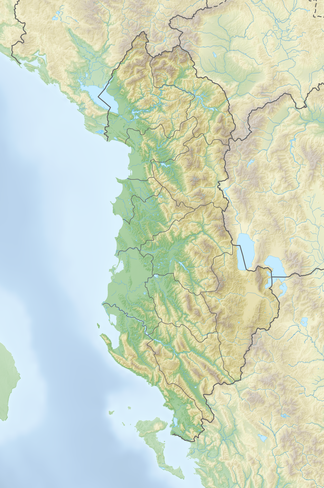Mali i Thatë
| Mali i Thatë | ||
|---|---|---|
|
View from the ascent to Pllaja e Pusit to the south to Mount Gramoz |
||
| Highest peak | Pllaja e Pusit ( 2287 m above sea level ) | |
| location | Albania | |
|
|
||
| Coordinates | 40 ° 53 ′ N , 20 ° 50 ′ E | |
The mountains Mali i Thatë ( German "dry mountain" ) are located in the south-east of Albania . It joins the south to the in the area of Northern Macedonia lying Galičica -Gebirge and separates as just this the basin of Lake Ohrid from Prespabecken . In the southwest and south, the Mali i Thatë closes the presparegion from the Korça plateau . The eastern slopes of the mountains are partly part of the Prespa National Park.
At 2287 m above sea level A. The Pllaja e Pusit is the highest mountain in the mountains. Only at one point in the south does a road cross the mountain range at the Zvezda Pass ( Albanian Qafa e Zvezdës ). The 1099 m above sea level. A. high pass connects Pustec (Liqenas) on Lake Prespa with the town of Korça. Immediately to the east of the pass, the 1768 m above sea level rises . A. high Mali i Ivanit .
The mountains rightly bear the name Trockener Berg, because in fact there are hardly any water sources in these mountains and not a single large stream has its source.
Many wolves live in the mountains, and bears are occasionally seen in the north on the border with North Macedonia.
Ecological problems
Whereas in the past the middle altitudes were densely covered with mixed oak forests, today Mali i Thatë is largely deforested. The inhabitants of the surrounding villages have always obtained their fuel from the forest, and wood is still used for heating and cooking. The forest was much more severely damaged by the large-scale illegal logging. This happened mainly in the years 1991–1998, when the state power in Albania was particularly weakened and not least the widespread corruption also contributed to the fact that the protection of the forest was impossible. Once the big old trees were cut down, natural regeneration was also prevented because many goats were grazed on the slopes and ate the young trees bare. In the meantime efforts are being made to protect the trees, at least in the area of the Prespa National Park. However, because of the erosion on many steep slopes, no more forest will grow back. There are still old trees in the particularly remote area west of the village of Gorica e Madhe. A secondary forest, protected by the park rangers, is now growing between this place and Gollomboç.
Lime is quarried at the Zvezda Pass and burned on the spot . As a result, the area is partially devastated, plus the strong emissions from the kilns.
swell
- Wolfgang Fremuth, Ferdinand Bego: Albania. Guide to it's natural treasures. Wardenburg 2002. ISBN 3-931323-06-4 , pp. 76-78.
- Romeo Eftimi: Hydrogeological characteristics of some karst transboundary aquifers of Albania and their environmental problems. P. 7 ff. (PDF; 2.06 MB)

